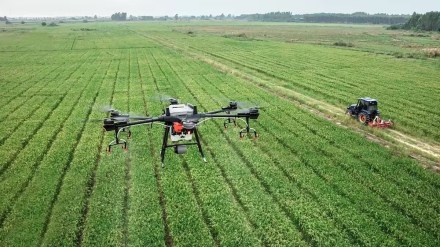To promote usage of nano urea and di-ammonium phosphate (DAP), leading fertiliser cooperative IFFCO on Tuesday announced procurement of 2500 drones to spray nano soil nutrients.
The cooperative sources said it has already placed an order for about 1,700 drones to be delivered by March 31, 2024.
Drones manufacturers like Garuda Aerospace, Paras Aerospace and IoTechWorld Avigation have confirmed to have received a major chunk of the orders from the cooperative.
The cooperative also stated that it would train 5000 rural entrepreneurs for the purpose. Usages of drones results in optimum usage of social nutrients.
The cooperative has signed an agreement for procurement of drones for spraying nano fertiliser in the field. The cooperative also announced procurement of 2,500 electric three wheelers to carry drones to farmers’ fields.
Sources said IFFCO had identified the Drone Federation of India after an evaluation for supply of these drones. The drones would be given free of cost to rural entrepreneurs.
The entrepreneurs would be given training and guidance to handle the drones, by IFFCO. According to a statement, one drone would be able to cover 20 acres of land per day spraying nano fertilisers and other water-soluble fertilisers.
Currently, Garuda Aerospace, IoTechWorld Avigation, Dhaksha Unmanned Systems, General Aeronautics and Paras Aerospace are the leading agri-drone manufacturers in the country.
“We are witnessing a surge in demand for agri-drones from agro-chemical players including fertilizer, pesticide companies and rural entrepreneurs and large-farm holder,” Deepak Bhardwaj and Anoop Upadhyay, co-founders of IoTechWorld Avigation, an agri-drone manufacturer, said in a statement.
IFFCO has launched nano urea in April 2021. Soil nutrient in liquid form provides nitrogen to plants as an alternative to conventional urea. A 500 ml bottle of nano urea is equivalent to a 45 kg bag of conventional urea.
In April this year, IFFCO also launched nano-DAP, which aimed at decreasing the country’s import dependence on soil nutrient variety.
According to agriculture ministry officials, drones are currently used for pesticide and liquid fertiliser applications, mapping of water spread area, water sampling, mapping macrophyte infestation, aquaculture management practices, etc.
Last year, the agriculture ministry had released standard operating procedures (SPOs) for the use of drones in pesticide and nutrient application.
To make drone technology affordable to farmers as well as to other service providers, the agriculture ministry, under the sub-mission on agricultural mechanisation, provides subsidies in the range of 40-100% for the cost of drones.
